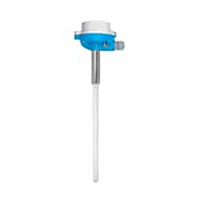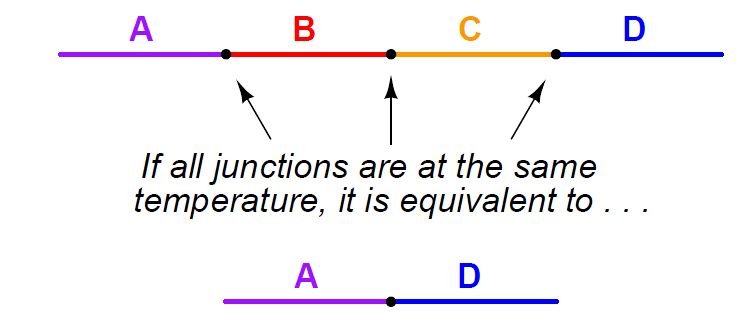
The law of thermocouples of intermediate metals
Intermediate metal thermocouple law: It is important to understand that the phenomenon of a “reference connection” is an inevitable effect of closing an electrical circuit in a circuit made of different metals. This is true regardless of the number of metals involved. In the last example, only two metals were involved: iron and copper. It forms an iron-copper (J1) junction at the end of the measurement and an iron-copper (J2) junction at the end of the indicator. Note that the J3 copper-copper bond has no effect because its identical metal composition does not generate any thermal voltage

But what about more complex thermocouple circuits, which include more than two types of wires? How can we define what a “reference connection” is or how it behaves when we have more than two different metal connections in the same circuit? For example, use this type of J-type thermocouple

Here are three voltage junctions
J1 iron and fixed, J2 iron and copper and J3 copper and fixed
After the first inspection, we seem to have a much more complicated situation than the two metals (iron and copper), but fortunately the situation is as simple as before, provided that the temperatures are J2 and J3, that if these two True connections are located very close to each other (in voltmeters). Note: A copper-constanton connection is normally a T-type thermocouple connection. A principle of electrical thermal circuits called the Law of Intermediate Metals helps us to see this clearly. Be the same. Representing this, the net effect of having four different metals (A, B, C, and D) coming together in series is the same as having only the first and last metal in that series (A and D) connected by a joint. If all intermediate connections are at the same temperature

The simple proof of the law of intermediate metals may be based on the law of conservation of energy, which is one of the most fundamental principles in all of physics. Consider what happens if we want to join a series of different metal wires shown in a continuous loop above:
In this diagram we see that the wire made of metal “A” is connected to a series of metal connections formed by metals “B”, “C” and “D”. If all these different metal connections are at the same temperature, there will be no temperature difference anywhere in the circuit to conduct current, so we expect the current in this circuit to be zero. This is in accordance with the Energy Conservation Act, which prohibits the passage of electrical current through a resistance wire without directing the actuator. Therefore, based on the assumption that energy must be saved (ie that an electric current cannot pass through any resistor without a current source), we must conclude that the net effect of all metal connections connected in series at the same temperature must be zero. . In other words, the connections AB, BC, CD and DA are all at the same temperature and are connected in series. They must produce zero voltage, as if these connections are all reduced to a single AA connection, which of course can not have any electrical force (voltage). ) To produce. Because it is no different from metals. If the law of intermediate metals was incorrect, it means that the ABCD junctions are not equal to the junction of AD only, meaning that they generate a different voltage from the DA junction at the right end of the circuit (while at the same temperature). And so this circuit generates some pure voltage to direct a current continuously through a resistance wire due to a violation of the law of conservation of energy. Since we know that the law of conservation of energy is established (and we can also construct such different metal ring circuits and detect their current as zero experimentally), we can be sure that the law of intermediate metals is correct. . In the J-type thermocouple circuit, where iron and station are attached to copper in both materials, we see copper as an intermediate metal between J2 and J3 joints. The same temperature is a reasonable assumption for J2 and J3 to be placed side by side on the indicator device, so we may use the law of medium metals and simply use J2 and J3 joints as a fixed ferrous iron reference joint. do. In other words, the law of intermediate metals tells us that we can treat the following two circuits equally

The practical significance of this rule is that we can always measure reference joints (s) as a single joint made of the same two types of metal as joints, as long as all metal joints are different at the reference point at the same temperature. To be placed. This fact is very important in the age of semiconductor circuits, where the connection of a thermocouple to an electronic amplifier involves a long series of connections of different materials. Here we see a large number of reference connections, which are formed by the necessary connections from the thermocouple wire to the silicon substrate inside the amplifier chip

Here we see the metals of the thermocouple wire (type J – iron and fixed) which are connected to a pair of brass terminal screws, which in turn join the copper plates on the printed circuit board, which lead to the lead / tin solder wire. Are connected, to which they are connected. Thin wires made of quarry, ending in gold traces on a silicon chip, which are attached to the silicon itself. Obviously, each of the complementary coupling pairs in this series loop terminates if each pair is at the same temperature (for example, the J12 gold-silicon bond cancels the J13 silicon-gold bond). Because they produce exactly the same voltage with opposite poles); Kovar-Gold J10 connection For this reason, cancel the Gold-Kovar J11 connection. Etc.). The law of intermediate metals goes one step further by saying that J2 to J13 joints, which are assembled in series, have the same effect as a fixed ferrous reference joint.The connection of temperature J2 occurs through J13
Rose Calibration Company in Melbourne, Australia with over ten years of experience provides all calibration, maintenance, and repair services throughout Australia. If you live in Sydney, Melbourne, Adelaide, Perth, Geelong, and Brisbane, you can receive your quote in less than two hours by fill-up the form via the “Booking” link.

